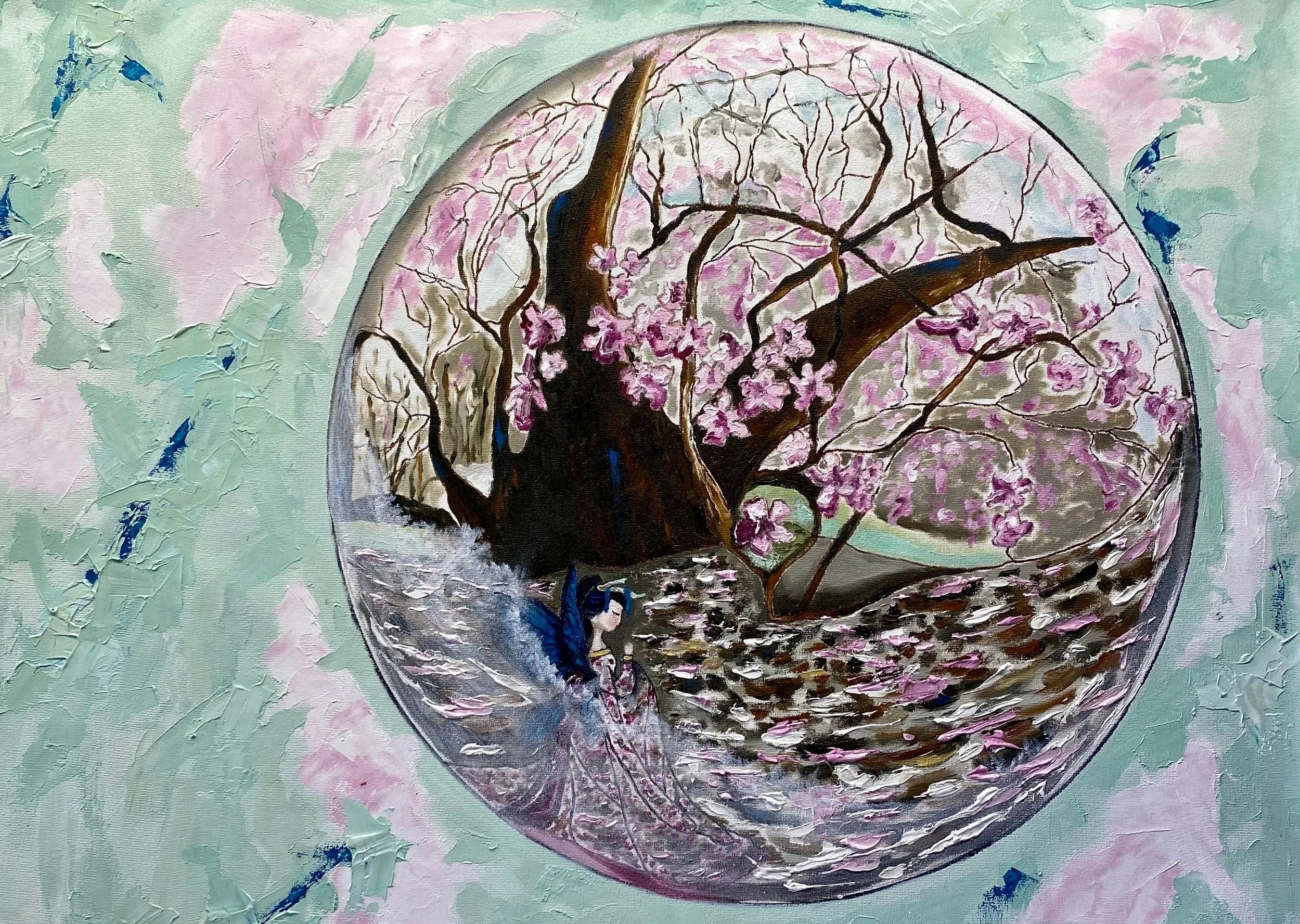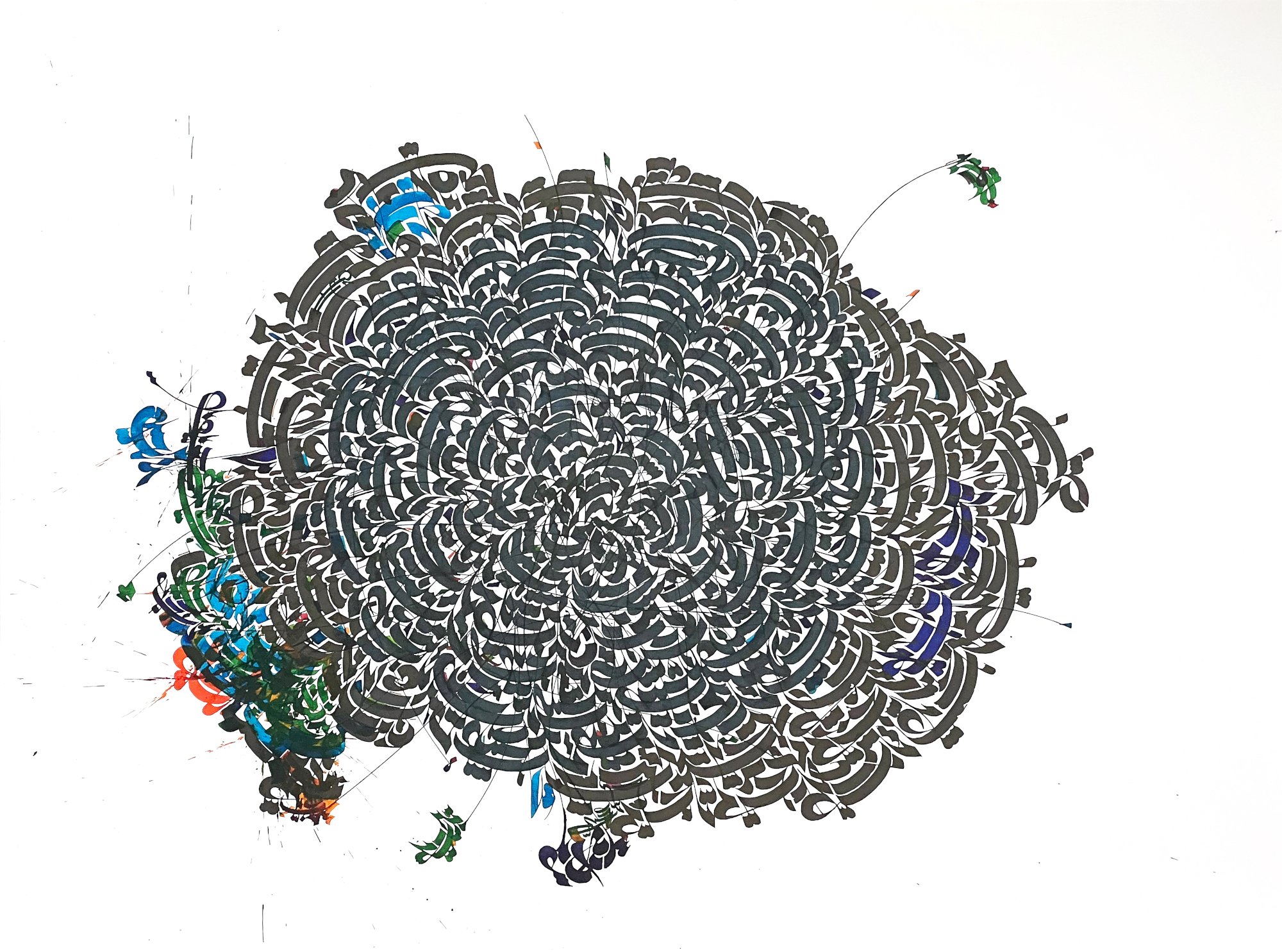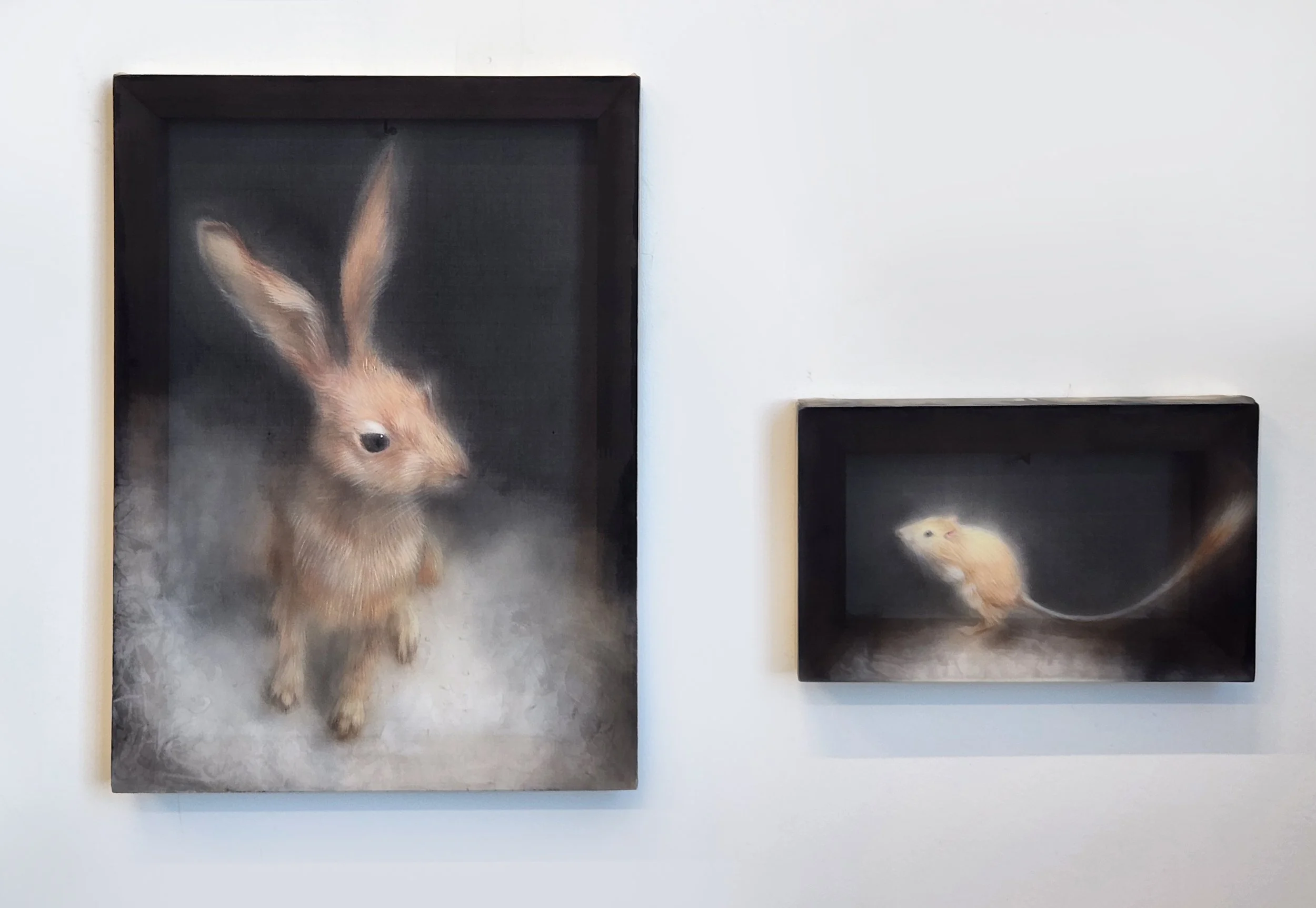10 Questions with Pato Reichler
Pato Reichler was born in Buenos Aires, Argentina. From a very young age, she has been passionate about art. She always painted and sang. She is also an engineer, but a few years ago, she decided to focus exclusively on painting. Although she worked on different themes using different techniques, for more than six years, she has dedicated herself to painting her own interpretation of the classic stories (Little Red Riding Hood, Butterfly Lovers, Puss in Boots, Pinocchio, and Alicia, among others). Her goal is to get through them to the most childish part that we all have inside. But at the same time, she also seeks to mobilize the viewer with the psychological side of her works. She works using different techniques: oil, collage, mixed media, pastels, and stained glass lacquer.
Pato Reichler - Portrait
ARTIST STATEMENT
Pato Reichler is a very persevering person, with clear objectives and she considers herself a good communicator. It is in that same line that she wants, and she tries to transmit emotions, mobilize, and give a message to the viewer.
She usually starts with a clear idea of what she is going to do, the main objective being the message she wants to convey. She thinks about it, sketches, rethinks the idea, locates the characters, and starts working with the colors and materials until she reaches the final result she was looking for.
As an artist, she overcame the barrier of “what will they say?”. Before, she was concerned about people's thoughts when seeing her works since she always developed very sensitive topics. Nowadays, she has managed to overcome this in part thanks to her work with the characters of the stories she paints; she shows very current realities and situations, and she has come to realize that people, in general, feel and identify with her work at some point. She has had a very good reception from different audiences, encouraging her to continue creating. In her life, certain triggers led her to develop the topics she represented in her works.
She always knew what she wanted to create. She was always passionate about classic stories, but she wanted to twist them. She tries to show the psychological part that all these stories have and demonstrate that, no matter how old the stories are, they are still very current. In her opinion, that is why people are attracted to her work; one way or another, they identify with it.
The story behind her works, well, that’s a tough one. “There are experiences that mark you, and you wish not to happen to anyone else…”. She also likes to express how important respect for the other person is and the importance of being able to tell someone: “Up to here, this is the limit”, or that you can always get out of the darkest and tangled forest. Also, she tries to raise awareness of the importance of caring for the environment and our planet.
She likes to work with topics that involve questions that people usually ask themselves and sometimes don’t dare to express. She wants her works to have much content and be mobilizing.
Butterfly lovers - Hope, Oil, 100 x 80 cm, 2023 © Pato Reichler
INTERVIEW
First of all, introduce yourself to our readers. Who are you, and how did you start experimenting with images?
I’m Pato Reichler, visual artist and engineer. I started painting classic tales, especially Brother Grimm’s tales when I was a little girl. Back then, I painted with tempera the images I pictured in my mind about stories from an amazing book written in German, which my father patiently translated and read aloud to me. I come from a German family, and reading those stories was a very common and exciting activity in my home.
When I finished school, I entered University and focused completely on the engineering course. After five years, I graduated with honors and received the gold medal for the best GPA in my class. Once I got the degree, I began working as an engineer, and I did it for many years, but deep down, I craved drawing, painting, and tales.
After some time, I got back to art: I painted different personal experiences, such as my trips to South Africa, Germany, and other places. I worked on conceptual art, created installations, worked with stained glass in the Cathedral of Saint Michael the Archangel in Buenos Aires, and explored various techniques of drawing, painting, and collage. I also attended several workshops and acquired higher artistic skills. Then I delved again into tales, but now with an adult perspective and the idea of painting my own interpretation of these stories and depicting their psychological side and everlasting relevance.
How would you define yourself as an artist today?
I’m a contemporary figurative and surrealist artist who wants to show the psychological side of these classic tales to stir the viewer’s emotions and feelings because although these tales are old, they are still very relevant in today’s world.
Butterfly lovers - SAKURA, Oil, 60 x 50 cm, 2023 © Pato Reichler
Can you tell us about the process of creating your work? What is your artistic routine when working?
First of all, I choose the tale on which I want to work (depending on the topic). Then I analyze it in detail; the ideas that I’m going to paint and the way in which I’m going to address them start flowing, and this takes about a week. After this, once I’ve already managed to visualize the work, I sketch it, and finally, I start working on the canvas. Having a clear idea of the finished work in my mind is essential to obtain the expected result, some sort of mental visualization.
Regarding my artistic routine, it varies according to the time of the year and my other daily activities. But, in general, once I’m ready to start on the canvas, I first draw, and only after two or three days, I start painting. This is because I need to decide how I am going to arrange all the colors, lights, and shadows that are in my mind and use them in the drawing.
Then there are some days when I can’t stop drawing until I see some results, and some others when I paint for a while, and then I leave it for the next day. It has to do with those moments of artistic inspiration.
The technique I like the most is oil painting, and most of my works are done in oil.
How did you evolve this way of working?
I just realized that giving my imagination free rein (which is one of my strengths) gave me incredible results when it came to painting… So basically that and also painting with the soul.
I’d say that painting with my imagination and soul has been key to me. That’s why part of my true self is present in all my works, and it’s hard for me to let them go.
Your paintings have surreal and almost fairy characters. How do you choose them, and what do they represent for you?
Yes, exactly, they’re characters from fairy tales, and I choose them according to the topic I want to address, I mean, the topic I want to talk about through my works. For example, in my Pinocchio series, I talk about the importance of education, as well as lies and conscience.
I believe that the characters of tales have a lot to say and their stories too. I just let them speak through the painting on the canvas.
Serie Caperucita - Actitud I, Pastel on paper, 45 x 35 cm, 2020 © Pato Reichler
Serie Caperucita - Should I trust, Pastel on paper, 50 x 40 cm, 2021 © Pato Reichler
How do you navigate the process of translating sensitive topics into your artwork, and what strategies do you employ to ensure that your message resonates with viewers?
Classic tales generally deal with profound topics from the past and present, remaining highly relevant. What I do is to highlight and delve into the underlying topic of the chosen story, bridging it to contemporary times. For this reason, when viewers see my work they understand that there is something more than just a mere story and, in general, get my point. Some of them want to know more and ask me questions, others reach their own conclusions by contemplating the work or associate the characters of the work with something they’ve experienced or are currently experiencing themselves.
The message always comes across. I see that all the time in the feedback I receive from the audience.
What other sources of inspiration do you have?
Regarding what triggers it, I’d say that everyday situations around us, but generally, things that I’d like to be different or that do no longer happen. That’s why many of my works subtly reflect some sort of criticism of society. Two artists have been my source of inspiration: Francisco de Goya and Edvard Munch.
Can you discuss the importance of conveying psychological depth in classic stories through your art and how you aim to make these narratives relevant and relatable to contemporary audiences?
I’m sure (because I’ve discussed it with clinical and educational psychologists) that these classic stories encompass a highly profound psychological content worthy of being showcased, and it’s quite a challenge for me to do so through my works.
I firmly believe that apart from mere aesthetics and skillful technique, art should embody meaningful content, and that’s what I try to achieve with my work.
In my works characters “speak”, tell a story and show a reality that can be identified by the viewer who, from their own perspective and personal experiences, contemplates the artist’s work. I think that messages are quite clear in my works, but they also let the viewer’s imagination run wild.
Serie Caperucita - Ningún miedo II, Oil, 100 x 80 cm, 2023 © Pato Reichler
Butterfly lovers - El reencuentro de las almas, Oil, 50 x 40 cm, 2023 © Pato Reichler
What do you think about the art community and market? And what are your strategies to engage with the market?
The art market is difficult and very competitive. Regarding the artistic community, you can find lot sorts of artists, but, in general, I’ve been really lucky and come across very nice people who are eager to help and share.
To enhance interaction and reach in the art market, I try to show and promote my works on social media and in exhibitions, galleries and international magazines.
I think that by covering a wider range of promotion methods, I reach more places and connect with a larger audience interested in art.
On the other hand, I’vrealizeded that the audience that is fond of my works generally wants to see creativity and content in the artistic project. And they choose my work because they are moved by t, because it’s different and “has something to tell th,em” or they feel identified with what’s going on in the painting in front of them.
I’ve sold some random works, but most of my clients have already bought many of them and sometimes even a whole series.
Lastly, what are you working on now, and what are your plans for the future? Anything exciting you can tell us about?
I’m currently working on a new project. It’s a triptych where each painting (although they have the same size and similar colours) deals with one of Grimm’s classic tales, which is not so well known. It’s a huge challenge because the three paintings convey different messages, but they are all quite strong and contemporary.
Something interesting to be told… Well, on March 13, 2024, I’m going to be awarded the International Prize Leonardo Da Vinci (Gold – Special Edition) in Milan, Italy, for artistic merit.
In addition to that, I am going to participate with my works in Florence Contemporary Gallery’s publication “55 Artists to watch: 2024 Edition”, which will be sold on Amazon. This year, I also have some exhibitions and art fairs here in Buenos Aires. Actually, from February 26 to April 29 of 2024 I’ll be exhibiting at the “Mercado de Carruajes” (a Historical Heritage Building) and I’m having conversations with an Austriac-German gallery owner to exhibit my works in their galleries in Vienna and Munich at the end of the year.
Artist’s Talk
Al-Tiba9 Interviews is a promotional platform for artists to articulate their vision and engage them with our diverse readership through a published art dialogue. The artists are interviewed by Mohamed Benhadj, the founder & curator of Al-Tiba9, to highlight their artistic careers and introduce them to the international contemporary art scene across our vast network of museums, galleries, art professionals, art dealers, collectors, and art lovers across the globe.






















